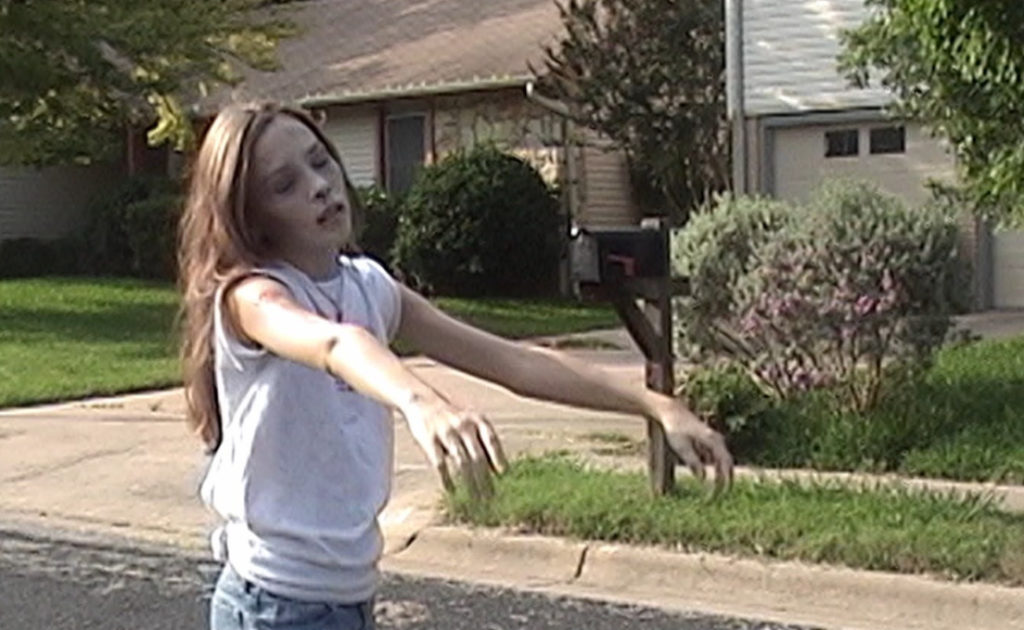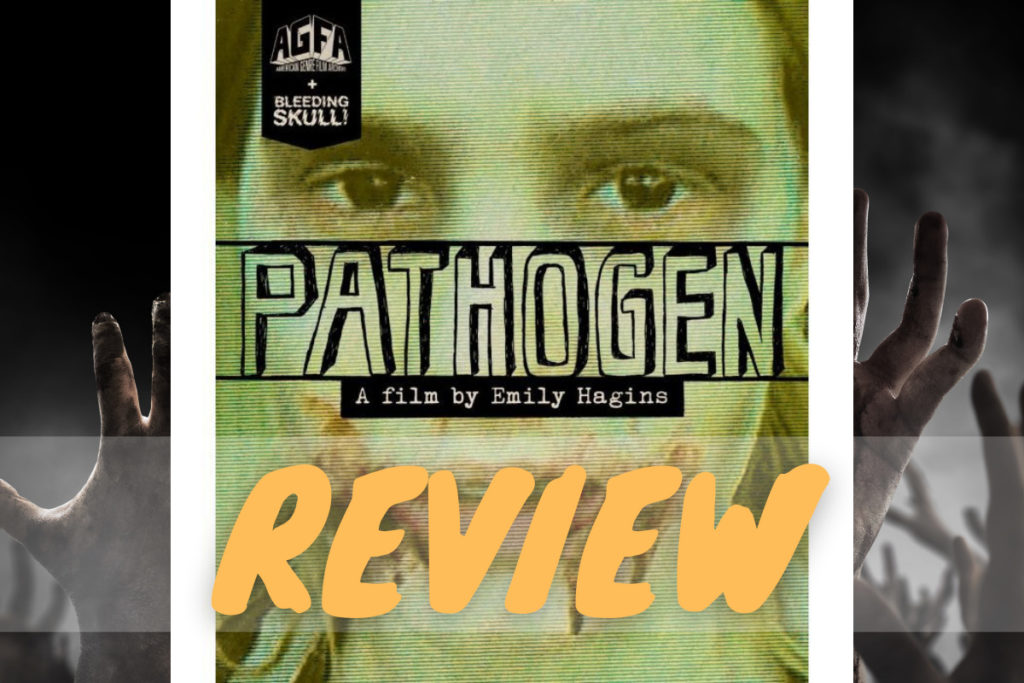What did you accomplish by the time you were 13 years old?
Did you perform a solo in choir?
Perhaps you got to the championship in your preferred sport?
If you’re Emily Hagins, you were at the Alamo Drafthouse in Austin, TX, premiering a feature-length zombie film that you wrote, cast, directed, shot, and produced.
Pathogen Review – Written by guest Kelly B.
Pathogen is the story of a zombie apocalypse spurred to life (or living death) by the accidental contamination of Austin’s water supply with a deadly nano-chip. What follows is the gory and violent experience of a decaying civilization … all from the perspective of a middle school girl.
The film was released on Blu-Ray by AGFA and Bleeding Skull on March 29, 2022, for its first major wide-release. Pathogen has all the hallmarks of the “Shot on Video” horror movement of the 80’s and 90’s: the buzzing ambient noise of the mounted mic picking up the tape spinning, cameos by the boom mic and reflections of the camera in a window, sound mixing that makes dialogue indistinguishable from non-diegetic music or unusually loud buzz tracks, the occasional botched edit with awkward lead-in, and the insecure acting and dialogue that only the amateur and young can create. It’s a film that is technically a mess with moments of clever editing, restraint in story-telling, and snappy pacing. However, like the works of the Polonia Brothers (Feeders, Terror House), David Prior (Sledgehammer), and Tim Ritter (Dirty Cop, No Donut; Wicked Games), what it lacks in professional presentation and execution, it compensates for with the honesty and heart that shines through. It’s in that charm and earnestness that the film leaves its indelible mark on viewers and recalls the youthful optimism inherent to burgeoning creativity.
As shown in the documentary Zombie Girl: A Documentary (which is a featurette on the AGFA Blu-Ray release), Hagins conceived Pathogen when she was only 10 years old, inspired by the film Undead which was shown during the 24-hour film marathon “Butt-Numb-A-Thon 5” organized by film critic Harry Knowles of Ain’t It Cool News. Knowles had invited Hagins to the event after receiving a letter from director Peter Jackson. Hagins had written to Jackson after falling in love with The Fellowship of the Rings, and Jackson wanted Knowles put Hagins in contact with Austin-based filmmakers to foster her passion for filmmaking. Following some internships on independent horror films, to include being the behind-the-scenes cameraperson and interviewer, she dedicated herself to making a feature-length zombie film.

Using MiniDV camcorders, a mic taped to a paint roller stick, and casting her friends and parents, she filmed and edited Pathogen on weekends and school holidays. In the post-production phase, she had her wallet, computer, and other equipment stolen, stalling the finalization of the movie. However, she was given a Texas Filmmakers Production Fund grant to finish editing and filming of pick up shots. After renting out the same Alamo Drafthouse Theater that spurred her filmmaking career, Pathogen premiered on March 25, 2006.
Emily Hagins is now 29 years old, and still making films. In 2017 she wrote and directed the Netflix Original Film Coin Heist, and contributed to the 2020 horror anthology Scare Package, which was released exclusively on Shudder. However, I dare say that her legacy will forever be tied to and anchored by the humble zombie film she made, and what it represents in the landscape of independent, passionate filmmakers.
Pathogen is only 66 minutes long, and the story shows the experience of the zombie uprising from the perspective of preteens. Before Stranger Things gave us young, scrappy suburban adventurers bearing the cross for saving the world from an overwhelming threat, Pathogen had 5 middle schoolers gathering in a suburban living room trying to escape the clutches of zombified children and turned adults, and pairing with a research scientist to find a cure. There’s a sense of genuineness in the dialogue and its hesitant delivery, where the kids seem to always trail off into a quiet reservation, or glancing away from their scene counterparts with a mix of insecurity and humble confidence that only the flux state of adolescence can foster. That shyness is present even in the shots of zombie attacks, where you’ll glimpse the occasional amused grin amidst the obviously restrained and weak attempts to wrestle an escape. This is a film any kid could have made with their friends, dipping their toes into the delicate film-making process, insecurities and blemishes intact. It’s that honesty, passion, and heart that radiates through every hitch and flaw. It’s the best of what filmmaking as a concept and ambition has to offer to dreamers, young and old alike.

At the risk of seeming sophomoric for bringing an elevated discussion to a zombie apocalypse film, I couldn’t help myself from noticing how our middle school protagonists were preyed upon by primarily those younger and older than them (elementary school-aged children and parents). It’s in this position, being squeezed between the childhood innocence they’ve left behind and the harsh reality of their nascent adulthood, that our adolescent mains find themselves being literally pulled apart by. The only adults who could offer protection from the dangers of the world manifesting around them are either parents that themselves are unable to offer guardianship any longer, or a research scientist who was the very reason for the outbreak, and whose hubris endangers the children even more. This sense of hopelessness and the inheritance of a world corrupted by the prior generation is not unlike the feelings Millennials and Gen Z share about the problems they were born into: climate change, economic disparity, and racial and social inequality. In a scene that is not lingered on long enough, one of our female protagonists stabs a man in the neck when he approaches them seeking help. After investigating his corpse, they learn he wasn’t a zombie. (“He’s got emotion in his face.”) Thematically you couldn’t ask for a more potent scene: no longer bound to the naivety and fragility of childhood, and approaching adulthood themselves, they see adults for what they are (especially for a young girl): a threat.
The film ends in a way that punctuates the experience in two ways: 1) forsaking of hope to fix or survive their new world, and 2) a freeze frame where we can clearly see the actor smiling while being attacked. In that moment we tie a bow on the theme and story, and see in a moment of unintended candidness the glee and fun of the filmmaking experience.
Kelly B. is a content creator on YouTube known as VaporKelly, primarily creating 50 Second Movie Reviews every weekday. You can connect with him on Twitter and other social media platforms listed on his Carrd.


Leave a Reply